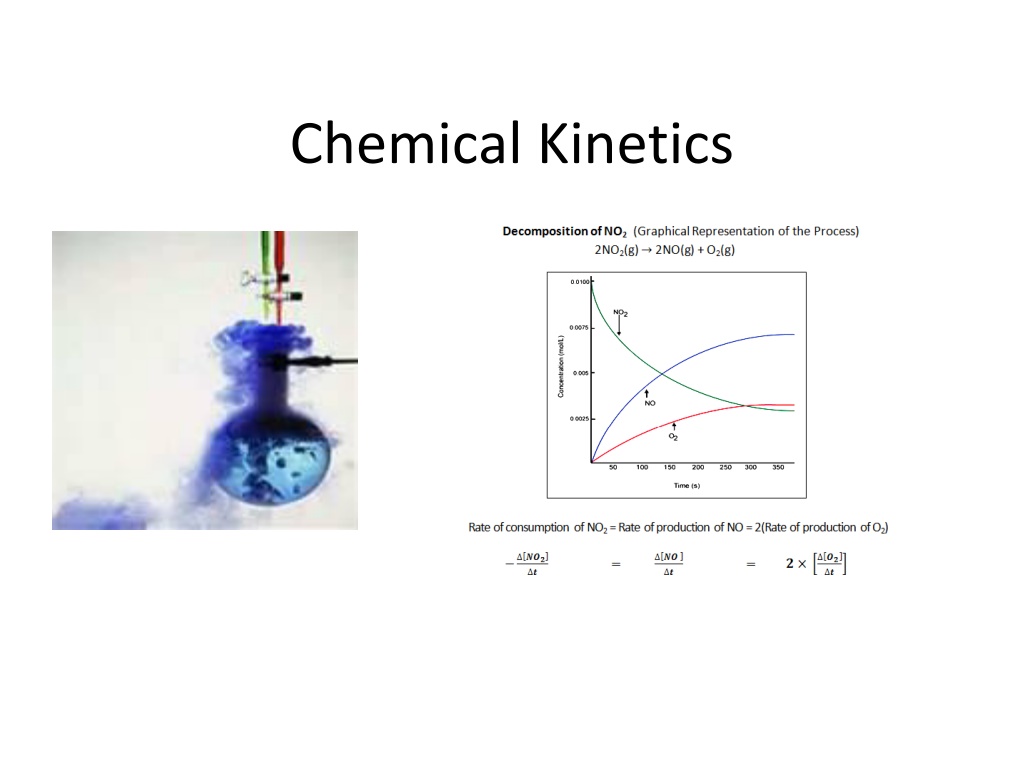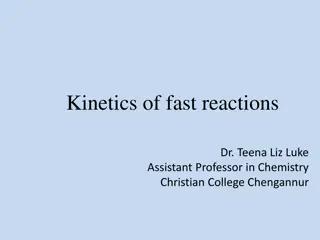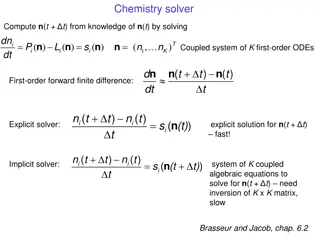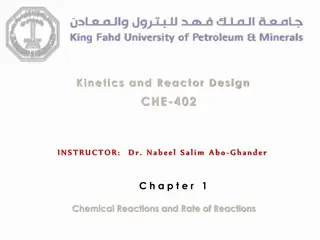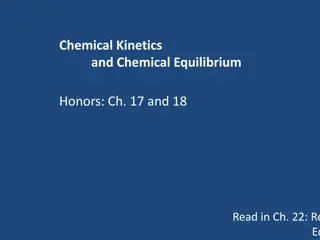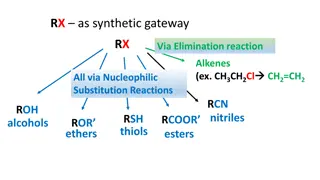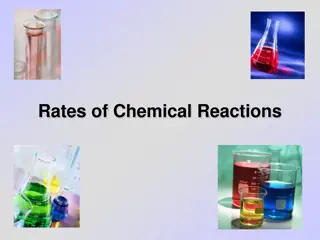Understanding Chemical Kinetics: Rates of Reactions and Factors Influencing Them
Chemical kinetics delves into the speed of chemical reactions and the factors that influence reaction rates. This field explores how collisions between atoms, ions, or molecules drive chemical reactions, as well as the role of catalysts, reactant concentration, temperature, and surface area. By understanding the mechanisms behind reactions, we can control and optimize chemical processes effectively.
Uploaded on Jul 18, 2024 | 0 Views
Download Presentation

Please find below an Image/Link to download the presentation.
The content on the website is provided AS IS for your information and personal use only. It may not be sold, licensed, or shared on other websites without obtaining consent from the author. Download presentation by click this link. If you encounter any issues during the download, it is possible that the publisher has removed the file from their server.
E N D
Presentation Transcript
Rates of Reactions When we speak of fast or slow, what do we mean? Any process can be described in terms of an amount of change over a period of time a rate. When we use think about rates of chemical reactions, we have to use chemical units with time in some way.
Fe (s) + O2(g) Fe2O3 This is a skeleton equation. What are the coefficients? 1 mole of Fe is converted into iron III oxide at the rate of 0.5 mole iron/year. Is this a fast or a slow process? What exactly is going on when oxygen reacts with iron?
Chemical kinetics is the field of chemistry that is concerned with the speed of chemical reactions (reaction rates) and the way these reactions occur. Rates of reactions can be understood by considering the conditions of chemical reactions: - temperature - concentration of reactants - surface area - presence or absence of a catalyst - the nature of the reactants
A 1-cubic-centimeter cube of sodium reacts more rapidly in water at 25 C than does a 1- cubic-centimeter cube of calcium at 25 C. The difference in rate of reaction is most closely associated with the different surface area of the metal cubes nature of the metals density of the metals concentration of the metals
Why do chemical reactions occur? Chemical reactions occur because of collisions between atoms, ions, or molecules of sufficient kinetic energy at the proper orientation. New chemical bonds are established when these effective collisions occur. Any factor that increases the number of effective collisions increases the rate of a chemical reaction. This view of chemical change has come to be known as collision theory.
Which event must always occur for a chemical reaction to take place? formation of a precipitate formation of a gas effective collisions between reacting particles addition of a catalyst to the reaction system
Simple Steps Many chemical reactions are actually a sequence of simple steps involving multiple collisions. These intermediate steps are not observed they happen very quickly but they contribute to overall reaction.
Considering the reaction consist of three intermediate steps: A B, it may Which step in this hypothetical reaction would have the greatest effect on the rate of reaction?
What is the effect of kinetic energy on reaction rates? Colliding particles must have sufficient energy to react with other particles. The minimum energy colliding particles must have to react is called the activation energy of a chemical reaction. This is usually represented diagrammatically. 2H2(g) + O2(g) ? 2H2O(g)
Exothermic Energy Diagram The activated complex is the arrangement of atoms at the peak of the activation energy barrier. The lifespan of the activated complex is usually very small 10- 13sec or so. It is sometimes referred to as the transition state.
Exothermic Energy Diagram In an exothermic reaction, the products have less energy than the reactants. Heat is released in exothermic processes.
Why are some reactions slow? Collision theory explains why some reactions like the formation of water or carbon dioxide from their elements are very slow they have high activation energies, often with multiple steps. At room temperature, molecular collisions are not energetic enough to overcome the activation energy barrier, so the reaction rate is close to zero.
Endothermic Energy Diagram In an endothermic reaction, the products have higher energy than the reactants Endothermic reactions tend to have high activation energy (Ea)
Reaction Rate Variables Temperature temperature usually speeds up chemical reactions at high temperature, reactant particles are more chaotic and more energetic than at low temperatures high temperatures increase the likelihood that the kinetic energy barrier (activation energy) will be breeched. Frequency of collisions also increases
Increasing the temperature increases the rate of a reaction by lowering the activation energy increasing the activation energy lowering the frequency of effective collisions between reacting molecules increasing the frequency of effective collisions between reacting molecules
Reaction Rate Variables Concentration the number of reacting particles in a given volume is a major contributor to the rate of chemical reactions more particles, more collisions As the concentration of reacting particles increases, the rate of reaction generally decreases increases remains the same
In each of the four beakers shown above, a 2.0- centimeter strip of magnesium ribbon reacts with 100 milliliters of HCl(aq) under the conditions shown. In which beaker will the reaction occur at the fastest rate? Beaker A Beaker B Beaker C Beaker D
Reaction Rate Variables Particle Size the total surface area of a solid or liquid is also very important smaller particle sizes have larger surface area per unit of mass larger surface areas have more collisions and higher reaction rates. Dissolving particles or grinding them into powder greatly increases reaction rates. Homogeneous mixtures of reactants react more quickly than heterogeneous mixtures. Why?
When a single 1-gram piece of zinc is added to 3 M hydrochloric acid at 25 C, the reaction is slow. Which procedure would most likely increase the rate of the reaction if the reaction were repeated? using 1 gram of powdered zinc using 1 M hydrochloric acid decreasing the temperature to 20. C decreasing the concentration of the zinc
Reaction Rate Variables Catalysts are substances that increase the rate of reaction without being chemically altered in the reaction they allow reactions to occur at a lower energy they lower the activation energy of reactions For example the formation of water can be catalyzed by Pt. Catalysts are written in chemical equations above the arrow:
Haber Process Fe/Al2O3/K2O N2(g) + 3H2(g) 2NH3(g) catalyst 13.6
Proteins Many proteins (enzymes) catalyze reactions by providing the right surface (provided by the amino acid structure) for chemical reactions to occur. The proteins lower the activation energy, allowing our body to synthesize and break down many compounds that normally have high energy barriers preventing their formation
Inhibitors and Poisons inhibitors are substances that interfere with the action of a catalyst. Famous inhibitors of hemoglobin: HCN and CO HIV drugs (and many others) are inhibitors Pesticides insecticides, herbicides, fungicides In biological systems, the products often inhibit their own formation (feedback inhibition)
The potential energy diagram shows the reaction X + Y Z. When a catalyst is added to the reaction, it will change the value of 1 and 2 1 and 3 2 and 3 3 and 4
A catalyst works by increasing the potential energy of the reactants increasing the energy released during a reaction decreasing the potential energy of the products decreasing the activation energy required for a reaction
Lab 15: Effect of Concentration on the Rate of a Chemical Reaction Objective We will study the effects of changing reactant concentration on the speed of a reaction. The reaction involves combining sodium thiosulfate (Na2S2O3) with hydrochloric acid (HCl). The products of this reaction include colloidal sulfur (S), which causes the heterogeneous mixture to become cloudy. By measuring the time it takes for print placed below a beaker to disappear, we can compare reaction rates under different conditions.
Materials Na2S2O3and HCl solutions 50 ml beaker timer Beral pipets three plastic cups
Procedure Take three plastic cups and fill them with thiosulfate, water, and HCl, respectively. Make sure you clearly identify which substance is in each cup they are all colorless! Get a beral pipet for each cup. In a clean dry beaker, place one squirt of thiosulfate into the beaker. Using a different pipet, place three squirts of water in the same beaker. Place your beaker over a piece of paper with a letter clearly drawn. Get your timer ready. Add a squirt of HCl and immediately begin timing. When the letter disappears, stop the time and write your time in the data table. Continue the process with different amounts of the thiosulfate solution, as directed by the table.
Squirts Thiosulfate Squirts HCl Squirts Water Time (s) 1 1 3 2 1 2 4 1 0
